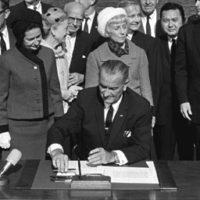NPG Forum Paper Marks the 50th Anniversary of Transformative 1965 Immigration Act
- NPG
- March 25, 2015
- Press Releases
- 0 Comments
NPG Forum Paper Marks the 50th Anniversary of Transformative 1965 Immigration Act
Authors examine how the 1965 Act – a vast social experiment with unforeseen consequences – revived mass immigration and fueled U.S. population growth.
View this release on PRWeb
This NPG News Release was picked up by 159 media outlets across the country – including every major television network – to reach a subscribed audience of over 130 million people.
Click here for a downloadable, printable PDF version
Alexandria, VA (March 25, 2015) – In response to celebrations around the nation commemorating the 50th Anniversary of the 1965 Immigration and Nationality Act, Negative Population Growth (NPG) is re-issuing an expanded Forum paper on March 30th. The new piece will combine analyses of the 1965 Act from both NPG Senior Advisor David Simcox and immigration historian Otis Graham. In A Vast Social Experiment: The Immigration Act of 1965, originally published in 2005, Graham studies the origins and unforeseen effects of the 1965 Act. In a new introduction to Graham’s masterful work, Simcox underscores the failure of the Act’s authors to consider U.S. population trends – or to even acknowledge the increasingly evident explosion of population and migration demand in the third world.
Titled Remembering the Immigration Act of 1965: The 50th Anniversary of a Population Game-Changer, the expanded paper highlights the dangerous impacts of irresponsible and expansionist immigration policies on U.S. population growth. Simcox notes: “Half a century ago this year, Congress enacted – and President Lyndon Johnson enthusiastically signed – a law broadly amending the Immigration and Nationality Act of 1952. This 1965 Act set up a radically different and far more receptive immigration regime for the United States.” While the 1965 Act is often hailed as a major victory in the battle for civil rights, the NPG Forum paper highlights the Act’s impact on nationwide population growth and immigration policy. “…Within a decade, it was widely recognized that the Act was a major legislative reordering of the size and composition of immigration flow – and a major stimulant to continued U.S. population growth in the wake of the 1947-1964 baby boom.”
The paper notes: “Looking at the apparent U.S. and world demographic trends of [1965], one suspects Washington legislative and Executive branch elites of the day were playing dumb about the likely consequences of the Act.” The well-documented effects of the Act are highlighted throughout the paper: rising immigration rates (despite massive U.S. population growth), soaring Latin American immigration (regardless of quota limits), and resulting “ad hoc policies” and “exceptions” (which have even further inflated annual immigration numbers). Graham adds: “…the 1965 law, and subsequent policy changes consistent with its expansionist goals, shifted the nation from a population-stabilization to a population-growth path, with far-reaching and worrisome consequences.”
Both authors note White House preferences to increase annual immigration rates – in 1965 and today. When John F. Kennedy was in office, Graham explains: “Whatever Congress might have had in mind on immigration, it was understood that real action waited on the President’s agenda.” Simcox highlights the continuation of this trend, noting President Obama’s plans to extend yet another amnesty to an estimated 11 million illegal aliens currently residing in the U.S. “Clearly, the U.S. began a decades-long immigration binge in 1965. It continues today.”
He adds: “Those trends – and the political advocacies they nourish – have given rise to interest-group-driven, fragmented, quick-fix immigration policies that admit favored populations outside of the terms of the basic legal immigration system.” Graham explains: “In the words of Harvard sociologist Christopher Jencks, [the Act] launched an ongoing ‘vast social experiment’ that conservatives inexplicably permit and liberals inexplicably sustain against the interests and sentiments of their working class base.”
Simcox concludes: “One trend which has grown since the 1965 Act underlies them all: the widespread, often unquestioned perception… that the U.S. vitally needs more people…. Ironically, the U.S. at this time seems to have adopted an implicit population policy: it could be summarized as ‘more.’ Clearly, the 50th ‘Anniversary’ of the 1965 Immigration Act is not an occasion for celebration. It should instead serve as an urgent warning to an expansion-minded Washington of the well-documented social and demographic consequences of short-sighted immigration policies….”


